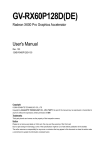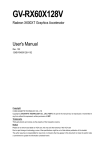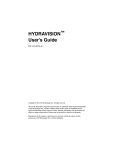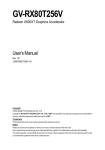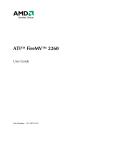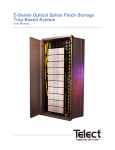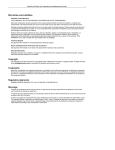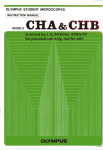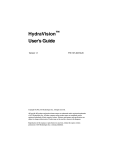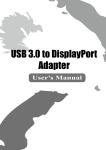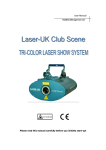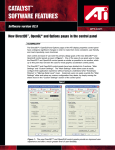Download D:\Release Manual\vga\r7500l\R7
Transcript
RADEONTM 7500 Graphics Accelerator USER'S MANUAL REV. 101 12MD-R7500L-101 Upgrade your Life GV-R7500L English Chapter 1 User’s Manual Copyright Copyright by GIGA-B YTE TECHNOLOGY CO., LTD. (“GBT”) No part of this manual may be reproduced or tr ansmitted in any from without the expressed, w ritten permission of GB T. Trademarks Third-party brands and names ar e the proper ty of their respective owners. Notice Due to rapid change in technology, some of the specifications might be out of date before publication of this booklet. The author assumes no responsibility for any errors or omissions which may appear in this document nor does it make a commitment to update the information contained herein. Please do not remove any labels on VGA car d , this may void the warranty of this VGA card. This product incorporates copyright protection technologythat is protected by method claims of certain U.S. patents and other intellectual property rights owned by Macrovision Corporation and other rights owners. Use of this copyright protection technology must be authorized by Macrovision Corporation, and is intended for home and other limited viewing uses only unless otherwise authorized by Macrovision Corporation. Reverse engineering or disassembly is prohibited. Oct. 31, 2002 Taipei, Taiwan GV-R7500LGraphics Accelerator -2 - English Table of Contents 1.INTRODUCTION 1.1. PREFACE .........................................................................................4 1.2. Overview ...........................................................................................4 2.HARDWARE INSTALLATION 2.1. UNPACKING .....................................................................................5 2.2. BOAR D LAYOUT ..............................................................................6 2.3. HARDWARE INSTALLATION ...........................................................7 3.SOFTWARE INSTALLATION 3.1Win98/98SE , WinME ,WinXP Dr iver And Utilities Installation ...........9 3.1.1 Operating system requirement....................................................9 3.1.2 DirectX installation .................................................................... 10 3.1.3 Driver installation ...................................................................... 12 3.1.4 Utilities on driver CD ................................................................. 15 3.1.5 Taskbar Icon ............................................................................. 16 3.1.6 Property pages ......................................................................... 23 3.2.WIND OWS NT 4.0 DRIVER IN STALLATION ............................... 31 3.3.WINDOWS 2000 D RIVER INSTALLATION .................................... 32 3.4 BIOS FLASH UTILITY .................................................................... 32 4.Troubleshooting Tips .......................................................................................33 5.Appendix 5.1.H ow to refash the BIOS .................................................................. 34 5.2.Resolutions and Color Depth Table ................................................ 36 -3 - Table of Content English Chapter 1.INTRODUCTION 1.1. PREFACE 1 Gigabyte Maya 7500 Series is a powerful and versatile graphic solution. 64MB of powerful DDR memory along with the RADEON ™ 7500 G PU provides high performance acceleration of today’s demanding 3D graphic applications. Industry leading DVD playback, 1.2. KEY FEATURES advanced 3D graphics n Unique H yper ZTM technology, enhence display memory bandwidth with 32 bit true color, and resolution up to 2048x1536. best for all 3D games n Support of DirectX 8 ® and OpenG L® applications n CHARISMA ENGINE™ supports full Transformation, Clipping and Lighting (T&L) at 45 million triangles/second peak processing capability n PIXEL TAPESTRY™ , the RADEON™ 7500 rendering engine, powers an incredible 1.74 gigatexels/second for the highest fill rates in 32-bit at high resolutions n Supported V-Tuner for performance tweaker. n Supported CRT, TV-out and S V ideo-out n DVD playback with integrated motion compensation and iDCT n Leading-edge H YDRA VIS ION technology supports traditional CRT monitors, flat panel displays and TVs. n VIDEO I MMERSION technology enables integration of industry-leading digital video features, including advanced de-interlacing algorithms for unprecedented video quality. GV-R7500LGraphics Accelerator -4 - User's Manual n Powered by the RADEON™ 7500 GPU and 64MB DDR memory for 2.1. UNPACKING The GV- R7500L package contains the follow ing: l The GV- R7500L graphics accelerator l l l l l ThisUSER'S MANUAL DVD Player software included Full Version game CD x1 , Lite version game x1 (CD x1) CD for driver with V-Tuner utilities S-Video cable WARNING! Expansion cards contain very delicate Integrated Circuit (IC) chips. To protect them against damage from static electricity, you should follow some precautions whenever you work on your computer. 1. Turn off y our computer and unplug pow er supply. 2. Use a grounded wrist strap before handling computer components. If you do not have one, touch both of your hands to a safely grounded object or to a metal object, such as the power supply case. 3. Place components on a grounded antistatic pad or on the bag that came with the components whenever the components are separated from the system. The card contains sensitive electric components, which can be easily damaged by static electricity , so the card should be left in its original packing until it is installed. Unpacking and installation should be done on a grounded anti-static mat. The operator should be wearing an anti-static wristband, grounded at the same point as the anti-static mat. Inspect the card carton for obv ious damage. S hipping and handling may cause damage to your card. Be sure there are no shipping and handling damages on the card before proceeding. MDO NOT APPLY POWER TO YOUR SYSTEM IF IT HAS BEEN DAMAGED ON THE CARD. MIn order to ensure your graphics card working correctly, please use offici al Gigabyte BIOS only Use none official gigabyte BIOS might cause problem on the graphics card. -5 - Hardw are Installation English 2.HARDWARE INSTALLATION English 2.2. BOARD LAYOUT GV-R7500L (8Mx16 64MB DDRAM) TV-Out VGA Monitor Connector (15pin) AV Output NTSC / PAL TV TV-out S-VideoOutput VGA Monitor Connector (15pin) Projector OR Analog LCD Monitor VGA Output Analog Monitor GV-R7500LGraphics Accelerator -6 - Installing Your Graphics card.. Now that you hav e prepared your computer, you are ready to install your graphics accelerator card. To install your graphics accelerator card: 1. P ow er off the computer and monitor, then disconnect the display cable from the back of your computer. 2. Remove the computer cover. If necessary, consult your computer's manual for help in remov ing the cover. 3. Remove any existing graphics card from your computer. Or, if your computer has any on-board graphics capability, you may need to disable it on the motherboard. For more information, see you computer documentation. -7 - Hardw are Installation English 2.3. HARDWARE INSTALLATION English 4. Locate the AGP slot. If necessary, remove the metal cover from this slot; then align y our Graphics card with the AGP slot, and press it in firmly until the card is fully eated. GV-R7500L Graphics card AGP Slot 5. Replace the screw to fasten the card in place, and replace the computer cov er. GV-R7500L Graphics card 6. Plug the display cable into your card; then turn on the computer and monitor. To TV or VCR To VGAMONITOR You are now ready to proceed with the installation of the Graphics card driver. For detailed instructions, select your operating system from the list below: GV-R7500LGraphics Accelerator -8 - In this manual, we assume that your CD-ROM Drive letter to be Drive D: 3.1. WINDOWS® 98 /98SE , WINDOWS ME and Windows XP DRIVER AND UTILITIES INSTALLATION The installation of Windows 98/98SE or Windows ME or Windows XP drivers is v ery simple. When you insert the driver CD into your CD-ROM drive, you can see the AUTORUN window (if it does not show up, run "D:\setup.exe"). Then you can follow guides to setup your GV-R7500L driver (Please follow the subsection 3.1.3 "Step By Step Installation" to install the driver for your graphics accelerator. 3.1.1.Operating system requirement l If your OS is Microsoft Windows, when loading the GV-R7500L drivers for the system, please make sure your system ( Windows 98/98SE or Windows ME)has installed DirectX8.1 or later. l If you install the GV-R7500L driv ers for the mainboard, w hich consist of SIS, ALI or V IA chipsets, please install the appropriate Driver program for that mainboard. Or please contact your motherboard nearest dealer for M/B Diver. -9 - Softw are Installation English 3.SOFTWARE INSTALLATION English 3.1.2.DirectX Installation Install Microsoft DirectX 8.1 to enable 3D hardware acceleration support for Win98/98SE/M E to achieve better 3D performence. Note: For software MPE G support in Win98/98SE or WinME, you must DirectX first install. MMust be install DirectX 8.1 (or later) 1. I nstallation DirectX Driver Click "Install DirectX 8.1” Item. 2.Click "Yes" icon. 3.Click "Yes“icon. GV-R7500LGraphics Accelerator - 10 - English 4.Click "OK" item. Then the DirectX 8.1 installation is completed. - 11 - Softw are Installation English 3.1.3.Driver Installation The following is the step-by-step installation guide. Step 1: New Hardware Found After GV-R7500L is inserted into y our computer at the first time, the windows will automatically detect a new hardware in the system and pop out a "New Hardware Found" message. Please select " Do not install a driver" and press OK. Step 2: Update Dev ice Driver Wizard: Standard PCI Graphics Adapter(VGA) 1.Click "Next“icon. MDon’t click “Cancel”, because the system will hang if you press it. Step 3: Update Device Driver Wizard: Finish At this time, system will ask for your Windows CD in order to complete the VGA driver installation. If you don't have the CD, you can press C:\Windows\System directory. Step 4: System Setting Change 2.Click "Finish“ icon. GV-R7500LGraphics Accelerator - 12 - English 3.Click "NO“icon. After the system has finished loading, insert the GV-R7500L driver CD disk into your CD-ROM, and then y ou can see the AUTORUN window. If it does not show up, please run "D:\setup.exe". Step 5: Driver Setup 1. Click " Install Display Driver(Radeon 7500 Series). 2.Click"Next". - 13 - Softw are Installation English 3.Click "Yes". 4. Click "Finish" to restart computer. GV-R7500LGraphics Accelerator - 14 - The utilities include Display Driver and V-Tuner utilities. Please browse the driver C D for detail. Other U tility (V-Tuner and Hydravision) Follow the setup that showing on the screen to install the Utility. A.Installing V-Tuner Utility Click "V-Tuner” Item. B.Installing Hydravision Utility Click "Hydravision Install” Item. - 15 - Softw are Installation English 3.1.4.Utilities on driver CD English 3.1.5 Taskbar Icon After installation of the display drivers, you w ill find an GBT icon on the taskbar's status area. Right-clicking this icon opens the GBT control panel, showing a menu composed of shortcute of the graphics card's enhanced and other functions. You may click the "Display Properties" item, and then click Settings. Click "Advanced" after clickng Settings. C lick the appropriate tab to change your display settings. Right click the icon. You can link to GBT website for updated information about the gr aphics card, latest driver s, and other information. GV-R7500LGraphics Accelerator - 16 - V-Tuner lets you adjust the working frequency of the graphic engine and video memory (Core Clock and Memory Clock) Min V-Tuner Display & Adjust Close V-Tuner Core Clock Display C ore Clock Display Memory Clock Display & Adjust Memory Clock Link to the Websit of Gigabyte Help description Close V-Tuner To system Tray - 17 - Softw are Installation English V-Tuner (Overclock Utility) English VGA Info VGA I nfo lists the relevant information about your card. Color Adjust Color Adjust allows you to make color adjustments, such as brightness, contrast, and gamma values for each or all of RG B colors. GV-R7500LGraphics Accelerator - 18 - on the taskbar's status area. 1. Rotate Screen 2.Using Single Display HYDRAVISION™ HYDRAVISI ON ™ and the Desktop Manager are activated whenever Windows® starts. Installing HYDRAVISION ™ adds menu options to the ATI Icon. Click on the ATI icon to access the application's features and help, or to unload the HYDRAVISION ™ Desktop Manager. 3.Hydravision HYDRAVISION ™ is primarily software designed for multiple monitor settings. RADEON 7500 graphic cards that have more than one display output can benefit fully from this software. A RADEON 7500 with only one display output can still take advantage of the many features of HYDRAVISION ™ . H YDRAVI S I ON ™ installation enables the Desktop M anager and creates a Window s ® program group for HYDRAVISION ™ display management software. - 19 - Softw are Installation English After installation of the display drivers, you will find an ATI icon Clicking this icon open the ATi control panel. English Desktop Management Controls : The Desktop Management dialog lets you configure the behavior of windows and dialog boxes in a multiple monitor environment. Dialog Control Enable dialog repositioning - Toggles dialog control on and off. When this box is checked, you can choose to have dialog boxes appear on the parent application's monitor. If the parent application or associated monitor cannot be located, the dialog box defaults to monitor 1. Show on app's monitor - This forces all open dialog boxes to the monitor that originated the applications. Show at cursor - You can choose to have dialog boxes appear on the monitor in which the cursor is located. Show on monitor - You can choose to have dialog boxes alway s appear on a specific monitor in the array Window Control Single monitor windows - When his box is checked, w indows are sized no larger than a single monitor. Windows that are placed on monitor splits are automatically relocated to the monitor on which most of the window appears. HydraV ision Max button management - A llows you to control the behavior of the Windows Maximize button. When HydraVision is running, a HydraVision Max/Restore button appears in the upper-right corner of an application title bar. C licking this button makes the active window maximize in one of two ways: Max to window corners causes windows to maximize to the monitor(s) that contain the window's upper-left and low er-right corners. Max to full desktop causes windows to maximize to the entire monitor array. Max child windows - Keeps windows generated by parent applications from splitting across monitors. The ability to keep child windows on a single monitor when maximized is extremely useful for editing multiple documents side-by-side in a parent application. The HydraV ision application title bar button changes from a single square to two smaller squares when a window is in a HydraVision maximized state. Clicking the button again restores the active window to its default state as a single square. General Application position memory - Check this box to "remember" the size and location of application windows when they are closed and re-apply those settings when the application is re-opened. Automatically align monitors - You can manually define monitor placement from the Settings dialog in the Display Properties dialog box. When this box is checked, H ydraVision will override user-defined monitor placement if the monitors are not evenly aligned. This control will work only if all monitors are running at the same resolution and your desktop is configured as a rectangle. Remove HydraVision title bar buttons - This box removes or restores the ATI title bar buttons from all applications. Remove MultiDesk system tray icon - This box removes or restores the MultiDesk sy stem tray icon. ATI Logo - C lick here to access the About dialog which provides software version information and a link to the ATI Technologies website. GV-R7500LGraphics Accelerator - 20 - Hot Keys Controls HydraVision allows you to specify hot key shortcuts for common operations such as starting applications and snapping applications to designated monitors. You can also disable all hot keys by checking the Disable hot keys box near the bottom of the Hot Keys dialog. Hot Keys only w ork if HydraVision is installed and loaded. Create/Remove Hot Keys To create custom hot key sequences: Select a Modifier key (Shift, Alt, etc.). Select a H ot key, and the Hot key function you want this key combination to perform. Click Add to enter your new combination in the Assigned hot keys list box. Click Apply to activate assigned hot keys. ATI recommends that a modifier key be used with any function key (F1, F2, etc.) assigned as a hot key. This will prevent interference with the function of these key s in individual applications. To delete a hot key from the Assigned hot keys list box: Highlight the hot key you want removed. Click Remove. Click Apply. Available Hot Keys You can use any assigned hot key at any time, from within any application, to change your display. SnapApp to Monitor allows you to move or "snap" active windows or dialogs from monitor to monitor for quick placement and v iewing of desktop contents. HydraV ision Popup Menu opens the HydraVision Desktop Management dialog. Run Application lets you start any application with a hot key. Gather All Windows to Monitor 1 allows y ou to find applications that are hidden or are open and - 21 - Softw are Installation English Load/Unload Desktop Manager - This button restores or removes the HydraVision Desktop Manager tracking program. Unloading the Desktop Manager returns display settings to Windows defaults. You should only select this option if you do not want to use any multiple monitor dialog box controls and window controls or hot keys. Desktop Manager will not reload automatically when Windows restarts. You will need to reload Desktop Manager from the Desktop Management dialog box. Load/Unload MultiDesk - This button restores or removes multiple desktop functionality. Individual Application S ettings - This button allow s you to specify, enable and disable desktop management settings for individual applications. To enable Individual Application S ettings: Individual Application Settings override the global settings defined in the Desktop M anagement dialog box. MultiDesk Properties - This button gives access to all the M ultiDesk P roperties. Here you can enable, disable, and name activ e desktops. MultiDesk will not reload automatically when Windows restarts. You will need to reload MultiDesk from the Desktop Management dialog box . English lost on disabled monitors. Find C ursor locates the cursor on a busy or crowded desktop. Switch to desktop scheme (X) switches from one desktop scheme to another. Next Desktop allows you to move up to the next active desktop. Previous Desktop allows you to mov e down to the next active desktop. Jump to Desktop allows you to configure a specific desktop to jump to. Move Application to Desktop allows y ou to move an active application to a predetermined desktop. Restore and Tile Windows tiles all open applications on one display. Minimize all apps on current monitor minimizes all open applications on the current monitor. Maximize app to Monitor maximizes minimized applications to a predetermined monitor. HydraFX HydraFX is only available in Windows 2000 and Windows XP. HydraVision HydraFX adds visual effects to your desktop. Configure the visibility of dialogs and drop down menus. Configure dialogs for fade in when opened. Add a shadow effect to dialogs. Visibility of windows and application menus can be independently configured. A window can be given added depth by enabling Shadow support. Transparency Control: 3D Controls: Transparency Control Enable Transparency while dragging windows - Check this box to enable the Visibility slider. Use the slider to set the degree of v isibility a window has when being dragged across the display. Enable Transparent menus - Check this box to enable the Visibility slider. Use the slider to set the degree of visibility application drop-down menus have. Enable Window fade-in - Check this box to cause an application window to slowly open or 'fade-in' to y our desktop. 3D Controls Enable Shadow support - Check this box to enable the Shadow support sliders. The Visibility slider sets the degree of visibility of the shadow. The S hadow slider sets how big a shadow is added to an application window or dialog. GV-R7500LGraphics Accelerator - 22 - The screen shows the information of display adapter, color, the range of display area and the refresh rate. Setting(Resolutions and Color depth for windows) The Setting properties page allows y ou to adjust the Direct 3D settings You can mov e the slider to the change resolution. You can click the item to change the color depth. Click "Adv anced" icon for adapter and setting. Options Properties n Version Inform ation provides the Cataly st v ersion number, 2D v ersion number and the driver build information. n Details button access to the Details tab which lists the card's hardware details and driver information. n Show D3D warning messages allows you to reactivate any disabled graphics warning messages. n Enable AT I taskbar i con application enables or disables the ATI taskbar icon. Howev er, this feature must be enabled for ATI hotkey support. n Show ATI i con on taskbar adds or removes the ATI icon from the taskbar. n Disable quick resol ution feature is accessible by left-clicking the ATI icon in the taskbar. n Reduce DVI frequency on high-resol ution displays enables or disables to reduce the DVI frequency when using high-resolution. - 23 - Softw are Installation English 3.1.6.Display Property pages English OpenGL Properties: The OpenGL properties page gives you complete control of the OpenGL settings. n Main Settings slider M ov ing the slider to the left will maximize application performance, while moving the slider to the right will provide excellent 3D image quality. Moving this slider from one position to the nex t changes the individual Custom Settings sliders found below. l Custom Setti ngs checkbox When Custom Settings is checked, the Main Settings slider is disabled, allow ing you to move each individual slider in the Custom Settings section below. Setting the individual sliders gives y ou complete control over your application experience. Using Custom Settings is recommended for advanced users only. n SMOOTH THVISION II l Anti-Aliasing checkbox improves image quality by remov ing jagged edges from 3D images, resulting in smoother, more natural looking objects. l Anti-Ali asing slider can be applied using different sample patterns and sample points such as 2X, 4X, or 6X. M oving this slider to the right increases sampling to prov ide the most realistic 3D image. l Ani sotropic Filtering checkbox uses a texture filtering technique that blends multiple texture samples together. Selecting Appl ication Preference will result in high quality textures, with a negligible reduction in the application's performance. l Ani sotropic Filtering slider By moving this slider to the right, as the number of samples taken increases, the quality of the final image increases significantly. 16X provides ex tremely detailed,crisp-looking images as a result of the largest number of tex ture samples possible. n Texture Preference sli der Selecting this decides w hether your application should use high quality or high performance textures. Moving the slider to the right delivers the highest quality experience. Moving the slider to the left emphasizes a high performance solution while still providing good visuals. n Mipmap Detail Level slider This will allow y ou to choose the texture quality of the mipmaps the application will use. Mipmaps are a collection of different sized textures of the same image. As the user moves closer to a 3D object the image quality should increase, requiring a higher quality texture of the same image. The base mipmap is the highest quality texture, and all subsequent mipmaps are smaller sized GV-R7500LGraphics Accelerator - 24 - l Force Z-buffer depth allows you to explicitly set the Z-Buffer depth. Most applications will work best when Disabled is selected. l Alpha dithering method l Support KTX buffer region extensi on Enabling this feature allows rapid updates of those portions of your screen that have changed. Note that most applications will not be affected by activating this feature. l Defaults button allows you to reset the OpenGL Compatibility S ettings to default values. n Defaults button This button allows you to reset the OpenGL Settings to default values. - 25 - Softw are Installation English tex tures of the same image. M oving the slider to the right selects a higher quality base mipmap, deliv ering the highest quality application ex perience. Moving the slider to the left selects a lower quality mipmap, delivering the highest application performance. n Wait for Vertical Sync This will lower the frame rate of full screen games but reduce the image tearing that can occur with the higher frame rate. Selecting Applicati on Preference allows the application to decide whether or not it should display its frames at the refresh rate of the monitor. Selecting Alw ays Off allows the application to run at its highest possible frame rate, regardless of the monitor’s refresh rate which is typically less than the frame rate at which the application will run. n Compatibility S ettings button This button allows you to access advanced settings that can solve compatibility issues for a few specific OpenGL applications. English Direct 3D Properties: The D irect 3D properties page allows you to adjust the Direct 3D settings. n Main Settings slider M ov ing the slider to the left w ill maximize application performance, while moving the slider to the right will provide excellent 3D image quality. Moving this slider from one position to the next changes the individual Custom Settings sliders found below. l Custom Setti ngs checkbox When Custom Settings is checked, the Main Settings slider is disabled, allow ing you to move each individual slider in the Custom Settings section below. Setting the individual sliders gives y ou complete control over your application experience. Using Custom Settings is recommended for advanced users only. n Anisotropic Filtering l Anti-Aliasing checkbox improves image quality by removing jagged edges from 3D images, resulting in smoother, more naturallooking objects. Selecting Application Preference will result in high quality images, with negligible reduction in the application's performance. l Anti-Ali asing slider can be applied using different sample patterns and sample points such as 2X, 4X, or 6X. M oving this slider to the right increases sampling to prov ide the most realistic 3D image. l Ani sotropic Filtering checkbox uses a texture filtering technique that blends multiple texture samples together. Selecting Appl ication Preference will result in high quality textures, with a negligible reduction in the application's performance. l Ani sotropic Filtering slider By moving this slider to the right, as the number of samples taken increases, the quality of the final image increases significantly. 16X provides ex tremely detailed,crisp-looking images as a result of the largest number of tex ture samples possible. n Texture Preference sli der Selecting this decides w hether your application should use high quality or high performance textures. Moving the slider to the right delivers the highest quality experience. Moving the slider to the left emphasizes a high performance solution while still providing good visuals. n Mipmap Detail Level slider This will allow y ou to choose the texture quality of the mipmaps the application will use. Mipmaps are a collection of different sized textures of the same image. As the user moves closer to a 3D object the image quality should increase, requiring a higher quality texture of the same image. GV-R7500LGraphics Accelerator - 26 - l Alternate pi xel center This may eliminate problems with some Direct 3D games which display vertical and horizontal lines around textures, or text that appears incorrect. However, this setting should only be used if y ou are experiencing the symptoms mentioned, as it may cause problems w ith other games. l Defaults button allows you to reset the Direct 3D Compatibility S ettings to default values. n Defaults button This button allow s you to reset the Direct 3D Settings to default values. - 27 - Softw are Installation English The base mipmap is the highest quality texture, and all subsequent mipmaps are smaller sized textures of the same image. Moving the slider to the right selects a higher quality base mipmap, deliv ering the highest quality application ex perience. Moving the slider to the left selects a lower quality mipmap, delivering the highest application performance. n Wait for Vertical Sync This will lower the frame rate of full screen games but reduce the image tearing that can occur with the higher frame rate. Selecting Applicati on Preference allows the application to decide whether or not it should display its frames at the refresh rate of the monitor. Selecting Alw ays Off allows the application to run at its highest possible frame rate, regardless of the monitor’s refresh rate which is typically less than the frame rate at which the application will run. n Compatibility S ettings button This button allows you to access advanced settings that can solve compatibility issues for a few specific Direct 3D applications. l Support W-buffer l Support 32bit Z-buffer dephth l Alphe dithering method l Support DT X texture formats allows applications to use this kind of texture format. There are a few applications that can only support a limited number of texture formats. By selecting Di sabled, the driv er will not support DTX tex ture formats, thus reducing the number of tex ture formats supported. English Color Properties: The Color Properties is used to adjust the color settings. It also allows gamma control for video playing of the Video Overlay. The color settings affect all display devices mapped to the view.You can change red, gr een, and blue display colors. Set Desktop and Video Overlay brightness (gamma) levels can also be changed. n Desktop brightness increases or decreases the color brightness of your desktop. The higher the gamma v alue, the higher the brightness and contrast of your display. n Col or Curve adjusts the selected color (red, green or blue) by mov ing the color curv e with your mouse. n Gam e Gamm a button accesses Game G amma properties. n Default resets the desktop brightness and color settings to the default v alues. n Red / Green / Bl ue sl iders These controls allow you to increase or decrease the color brightness of Direct 3D and OpenGL games play ed in fullscreen mode. (NOTE: Game G amma is NOT supported in Windows NT4.0) n RGB Lock adjust the RG B sliders individually or adjust all three sliders at the same time. n Default resets the Game Gamma settings to the default v alues. GV-R7500LGraphics Accelerator - 28 - If you VGA card is equipped with a S-Video connector , you can use a second output device (e.q. a TV or a computer monitor) as part of your operating desktop extending your desktop to second device or copying your desktop on the second device. Select Display Type Enable /Disable”Extend my w indows desktop onto this monitor The Display tab provides the multi monitor features. Here you can enable/disable display devices and swap the assignment of Primary and Secondary displays. Connecting your graphics card to a TV or VCR Turn off your computer and your television (or VCR). Ensure your graphics card is installed correctly. For information about placing the card in your comput er and installing the enhanced graphics driver, see the user’s manual. Determine if your television (or VCR) has an S-Video or Composite video connection. Looking at the back of your computer, locate your graphics card. U sing an S-Video cable or the supplied adapter cable, attach one end of the cable to y our graphics card and the other to y our television (or VCR). See “Connecting your graphics card to a TV (or VCR)” on the following page. - 29 - Softw are Installation English Display Properties: English Overlay Properties The Overlay Properties is used to adjust the Brightness / C ontrast / Saturation / H ue / Gamma settings. Overlay properties allows for the view ing of full-motion video on your PC . However, there is only one v ideo overlay, which is only available on the Primary display. The video overlay controls are automatically activated during playback of any video file type that supports overlay adjustments. n Overlay Adjust ments l Brightness allows y ou to adjust the brightness of the video image. l Contrast allows you to adjust the contrast in the video image. l Saturation allows you to adjust the vividness of the color. Sliding it all the way to the left removes all color and produces a black and white picture. l Hue allows you to adjust the pureness or tint of the red, green and blue components of the color. l Gamm a allows y ou to adjust the overall intensity of the video image. n Difaults button allows y ou to reset the Overlay settings to default values. n Theater Mode checkbox allows you to display video playback in full screen on a secondary monitor, if available and enabled. Rotation Properties: The Rotation Properties is used to rotate the screen. If your monitor is capable of operating in either Landscape or Portrait mode, you can adjust the screen by this proper ties. n Rotation l Standard Landscape allows you to set the screen at standard landscape. l Rotate 90° Right allows you to rotate the screen clockwise 90°. l Rotate 180° allows you to rotate the screen 180°. l Rotate 90° Left allows you to rotate the screen counterclockw ise 90°. n Configure Hotkeys allows you to set the screen rotation by Hotkeys. n Defaults button allows you to reset the hotkey. GV-R7500LGraphics Accelerator - 30 - Please make sure the Window s NT 4.0 have installed Windows NT 4.0 Service Pack version 6.0 (or later) before installing the GV-R7500L graphics accelerator driv er. To install the GV-R7500L driver for Windows NT 1. Insert the INSTALLATION CD into your CD-ROM drive. If Windows ® runs the CD automatically. 2. Click Start. 3. Select Run. 4. Type the following: D:\SETUP (If D is not your CD-RO M drive, substitute D with the correct drive letter.) 5. Click “OK”. 6. Click on “Install Display Drivers(Radeon 7500 Series)” to begin the Installation Wizard. 7. Click “Next”. 8. Click “Yes” to the license agreement. 9. Follow the Wizard's on-screen instructions to complete the installation. - 31 - Softw are Installation English 3.2. WINDOWS NT 4.0 DRIVER INSTALLATION English 3.3.WINDOWS 2000 DRIVER INSTALLATION Please make sure the Windows 2000 have installed Windows ® 2000 S ervice Pack version 2 (or later) before installing the graphics accelerator driv er. With Windows ® 2000 running on your computer, y ou need to install the GV-R7500L driver to take adv antage of the higher performance, resolutions, and special graphic features of the Graphics card. To ensure you install the latest driv er, use the Installation CD that shipped with your Graphics card. To install the GV-R7500L driver for Windows ® 2000 1. Insert the INSTALLATION CD into your CD-ROM drive. If Windows® runs the CD automatically. 2. Click Start. 3. Select Run. 4. Type the following: D:\SETUP (If D is not your CD-RO M drive, substitute D with the correct drive letter.) 5. Click “OK”. 6. Click on “Install Display Drivers(Radeon 7500 Serie)” to begin the Installation Wizard. 7. Click “Next”. 8. Click “Yes” to the license agreement. 9. Follow the Wizard's on-screen instructions to complete the installation. 3.4.BIOS FLASH UTILITY GV-R7500L BIO S update procedure: M Note: Please download the newest BIOS from our website (www. gigabyte.com.tw) or contact . your local dealer for the file. M If you want to realize the BI OS flash information, please refer to detail on P.34 GV-R7500LGraphics Accelerator - 32 - TroubleshootingTips 4.Troubleshooting Tips The following troubleshooting tips may help if you experience problems. Contact your dealer or GBT for more advanced troubleshooting information. n Check that the card is seated properly in the AGP slot. n Ensure the display cable is securely fastened to the card's display connector. n Make sure that the monitor and computer ar e plugged in and receiving power. n If necessary, disable any built-in graphics capabilities on your motherboard. For mor e information, consult y our computer 's manual or manufacturer. (NOTE: Some manufacturers do not allow the built-in graphics to be disabled or to become the secondary display.) n Make sure you selected the appropriate display device and graphics card when you installed the graphics driver. n For more troubleshooting tips, right-click the ATI icon in the taskbar and select Troubleshooting. n If you have problems during bootup, start your computer in Safe Mode. In Windows® 98 SE and Windows ® Me, press and hold the CT RL key until the Microsoft ® Windows ® Startup Menu appears on the screen. Then select the number for Safe Mode, and press Enter. (You can also use F8 to bring up the Microsoft Windows ® Star tup Menu.) In Safe Mode, bring up the Device Manager ..and check for duplicate display adapter and monitor entries if you are only using one graphics card. n For more assistance, use the Troubleshooting Guide located in the Windows® Help or contact your computer manufactur er. 33 English 5.Appendix 5.1. How to reflash the BIOS MWe use GV-AR 64SH VGA card and Atiflash BIOS flash utility as example. How to reflash the BIOS for your MAYA serial (Chip by ATi) graphics card? 1. Extract the Zip file to the drive C: or A: 2. Restart your PC in MS-DOS mode (This function only for Windows 95 or Windows 98, If y our OS is Window s 2000 / Windows Me / Windows XP, please use the bootable disk to MS-DO S mode) GV-R7500LGraphics Accelerator - 34 - English 3. Change the command path to the file location C:\> or A:\> 4. Reflash BIOS command as below : C:\> atiflash - p 0 <filename> 5. Reboot y our PC when it's done. - 35 - Appendix English 5.2.Resolutions and Color Depth Table Radeon 7500 2D Single DisplayModes Dis play Refresh Screen Rate Resolution (Hz) 60 72 75 640x480 85 90 100 120 160 200 60 70 72 800x600 75 85 90 100 120 160 200 60 70 72 1024x768 75 85 90 100 Hor. Scan (KHz) 31.5 37.9 37.5 43.3 45.4 50.9 61.8 84.3 108.0 37.9 43.7 48.1 46.9 53.7 56.8 63.6 77.1 105.4 135.0 48.4 56.5 57.6 60.0 68.7 72.8 81.4 GV-R7500LGraphics Accelerator Pixel Clock (Mhz) 25.2 31.5 31.5 36.0 37.8 43.1 52.4 72.8 95.0 39.9 45.5 50.0 49.5 56.3 60.0 68.1 83.9 116.4 149.0 65.0 75.0 78.4 78.8 94.5 100.1 113.3 Color Depth (bpp) 8bpp(256 color) Standard mode P P P P P P P P P P P P P P P P P P P P P P P P P P - 36 - 16bpp(65K color) High mode P P P P P P P P P P P P P P P P P P P P P P P P P P 32bpp(16.7M) Truemode P P P P P P P P P P P P P P P P P P P P P P P P P P . To be continued.. Hor. Scan (KHz) 98.7 116.6 125.7 134.8 172.8 38.0 41.7 53.7 63.0 67.5 72.4 77.0 91.5 111.1 141.4 151.6 60.0 69.8 72.0 75.0 85.9 101.6 123.8 168.9 46.2 50.9 64.0 74.7 76.8 79.1 80.0 91.1 97.2 108.7 Pixel Clock (Mhz) 139.0 164.2 176.9 192.0 246.1 56.0 62.1 81.6 96.7 108.0 112.3 119.6 143.4 176.0 226.3 242.6 108.0 120.6 124.5 129.6 148.5 178.9 217.8 300.0 77.6 85.5 108.0 129.0 132.8 136.7 135.0 157.5 169.5 191.3 Color Depth (bpp) 8bpp(256 color) Standard mode P P P P P P P P P P P P P P P P P P P P P P P P P P P P P P P P P P - 37 - 16bpp(65K color) High mode P P P P P P P P P P P P P P P P P P P P P P P P P P P P P P P P P P 32bpp(16.7M) Truemode P P P P P P P P P P P P P P P P P P P P P P P P P P P P P P P P P P To be continued.. Appendix English DDisplay Refresh Screen Rate Resolution (Hz) 120 140 150 1024x768 160 200 43 47 60 70 75 1152x864 80 85 100 120 150 160 60 70 72 1280x960 75 85 100 120 160 43 47 60 70 72 74 1280x1024 75 85 90 100 English DDisplay Screen Resolution 1280x1024 1360x768 1400x1050 1536x864 1600x900 1600x1000 1600x1024 1600x1200 Refresh Rate (Hz) 120 160 62 60 60 85 100 120 160 60 75 85 100 120 60 75 85 100 120 76 52 58 60 65 66 70 72 75 76 85 92 100 Hor. Scan (KHz) 131.8 179.4 49.4 64.0 53.8 76.9 91.5 111.2 151.3 56.0 70.5 80.1 95.5 115.6 62.1 78.1 89.3 105.9 128.4 81.4 64.2 71.9 75.0 81.3 82.2 87.5 90.0 93.8 95.5 106.3 116.2 127.2 GV-R7500LGraphics Accelerator Pixel Clock (Mhz) 234.0 321.5 88.6 108.0 109.3 160.7 191.7 234.9 322.1 119.3 152.4 174.4 209.3 255.3 133.2 168.8 194.4 232.2 283.5 178.2 138.4 155.3 162.0 175.5 178.9 189.0 195.8 202.5 209.3 229.5 256.5 280.8 Color Depth (bpp) 8bpp(256 color) Standard mode P P P P P P P P P P P P P P P P P P P P P P P P P P P P P P P P - 38 - 16bpp(65K color) High mode P P P P P P P P P P P P P P P P P P P P P P P P P P P P P P P P 32bpp(16.7M) Truemode P P P P P P P P P P P P P P P P P P P P P P P P P P P P P P P P To be continued.. Refresh Rate (Hz) 86.52 60 1792x1344 75 85 60 1800x1440 70 90 1856x1392 60 72 75 90 60 1920x1080 70 75 85 1920x1200 60 72 75 76 80 85 1920x1440 60 60 75 2048x1152 85 100 60 70 2048x1280 75 85 90 60 66 2048x1280 70 75 * GBT no guarantee Hor. Scan (KHz) 116.2 83.8 106.3 119.7 89.5 104.9 136.7 86.5 104.0 112.5 132.1 67.1 78.7 84.5 96.5 74.7 90.0 94.1 95.2 100.3 106.9 90.0 71.5 90.0 103.1 122.0 79.5 93.2 100.3 114.0 121.6 95.2 105.5 111.9 120.1 Pixel Clock (Mhz) 256.5 205.2 261.0 294.9 219.9 259.2 340.2 218.7 264.6 288.0 340.2 172.8 205.2 220.5 253.1 193.5 236.3 246.9 249.8 263.3 282.3 234.0 198.0 252.0 290.3 345.6 221.4 261.0 280.8 321.0 344.3 266.6 297.0 315.2 340.2 Color Depth (bpp) 8bpp(256 color) Standard mode P P P P P P P P P P P P P P P P P P * * * P P * * * P * * * * P * * * - 39 - 16bpp(65K color) High mode P P P P P P P P P P P P P P P P P P * * * P P * * * P * * * * P * * * 32bpp(16.7M) Truemode P P P P P P P P P P P P P P P P P P * * * P P * * * P * * * * P * * * Appendix English DDisplay Screen Resolution 1600x1280 English GV-R7500LGraphics Accelerator - 40 -








































